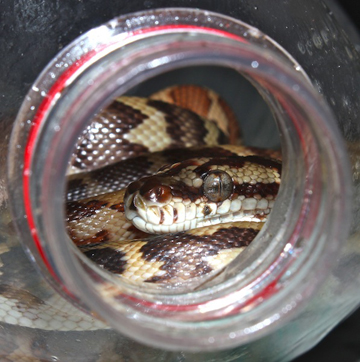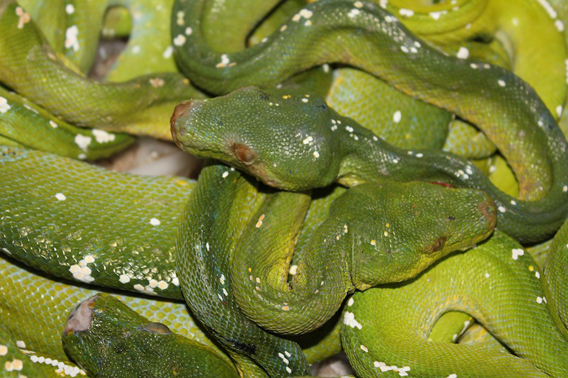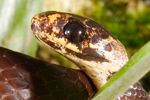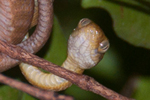
Illegally traded lizards (left to right): black tree monitor (Varanus beccarii), Reisinger’s tree monitor (Varanus reisingeri), emerald monitor (Varanus prasinus), and the blue-spotted tree monitor (Varanus macraei). Photo courtesy of Jessica Lyons.
Demand for exotic pets is driving the illegal harvest and trade of herpetofauna (reptiles and amphibians) in Indonesian New Guinea, according to a recent study published in the journal Biodiversity and Conservation.
Between September 2010 and April 2011, Daniel Natusch and Jessica Lyons of the University of New South Wales surveyed traders of amphibians and reptiles in the Indonesian provinces of Maluku, West Papua and Papua.
The authors encountered a slew of species being exploited for trade including: the green python (Morelia viridis), boelens python (Morelia boeleni), frilled necked lizard (Clamydosaurus kingii), New Guinea snapping turtle (Elseya branderhorsti), blue tongue lizard (Tiliqua scincoides), the green tree frog (Litoria caerulea), and several species of monitor lizards (Varanus sp.).
According to the paper, they recorded, “5,370 individuals representing 52 species collected solely for the pet trade. At least 44 % were either fully protected or had not been allocated a harvest quota, making their harvest and trade illegal. Approximately half were listed within the Convention on International Trade in Endangered Species of Wild Fauna and Flora (CITES).”
 Wild carpet pythons (Morelia spilota) are traded on a legal quota system, but researchers say the quota is often exceeded. Photo courtesy of Jessica Lyons. |
CITES, which Indonesia became a party to in 1979, regulates international wildlife trade. Under CITES, certain species are assigned a harvest quota; a specific number of individuals that can be collected from the wild. Animals listed as “fully protected” or without an assigned harvest quota cannot be legally collected or traded.
The Directorate General of Forest Protection and Nature Conservation (PHKA) is responsible for the monitoring and enforcement of CITES regulations in Indonesia. Natusch and Lyons’ findings suggest that there are some key gaps in PHKA’s enforcement.
“Illegal trade is due, partly, to an inadequate understanding of the species being traded and is facilitated by poor monitoring and enforcement at key trade hubs,” they write.
A 2011 paper, also by Lyons and Natusch, focusing on the illegal laundering of green pythons asserted similar findings. A report submitted by Indonesia at the CITES Asian Snake Trade Workshop in 2011 claimed that there was no illegal trade in Indonesian snakes. However, Lyons and Natusch uncovered a different story—that breeding farms were being used to illegally launder wild caught snakes.
Between April 2009 and Sept 2011, the authors surveyed traders who supplied the market for green pythons (Morelia viridis). Commercial trade in green pythons is legitimate when the traded individuals are bred in captivity, but harvesting green pythons form the wild is strictly illegal. However, it appears that many traders are taking advantage of an inadvertent loophole in the system. Local collectors harvest snakes in the wild, and sell them to breeding farms, which pass these snakes off as captive bred.
“Extrapolation of monthly collection estimates provided by traders revealed that at least 5,337 green pythons are collected each year, suggesting that at least 80% of the green pythons exported from Indonesia annually are illegally wild-caught,” the scientists wrote last year.
The authors suggest many methods to counter the laundering of illegally caught wildlife. One novel method is ensuring that the snakes are sold along with their eggshells, which can be measured to verify authenticity.
“Merely the requirement of having to enclose eggshells within shipments (and not even measuring them) would curtail much of the trade,” Lyons told mongabay.com.
As of yet, this method has not been implemented.
In addition, Natusch and Lyons recommend, “the need for increased monitoring and enforcement, improving the knowledge base of species traded and educating consumers about the effects their demand for pets has on these species.”

Illegally traded green pythons (Morelia viridis) in the black market pet trade. Photo courtesy of Jessica Lyons.

Illegally traded blue-spotted tree monitor (Varanus macraei) in a crate. Photo courtesy of Jessica Lyons.

Illegally traded green python (Morelia viridis) with head injury likely due to being in a cramped, wet cage. The snake may have rubbed itself raw trying to escape. Photo courtesy of Jessica Lyons.
CITATION: Lyons, J.A., Natusch, D.J.D. Wildlife laundering through breeding farms: Illegal harvest, population declines and a means of regulating the trade of green pythons (Morelia viridis) from Indonesia. Biological Conservation. (2011), doi:10.1016/j.biocon.2011.10.002
Natusch, D. J. D., and Lyons, J.A. Exploited for pets: the harvest and trade of amphibians and reptiles from Indonesian New Guinea. Biodiversity and Conservation. (2012),
doi: 10.1007/s10531-012-0345-8
Related articles
Remarkable comeback: blue iguana downgraded to Endangered after determined conservation efforts
(10/23/2012) The wild blue iguana population has increased by at least 15 times in the last ten years, prompting the IUCN Red List to move the species from Critically Endangered to just Endangered. A targeted, ambitious conservation program, headed by the Blue Iguana Recovery Team, is behind this rare success for a species that in 2002 only numbered between 10 and 25 individuals.
Scientists name new snake species to criticize mine plans in Panama (photos)

(09/18/2012) While scientists increasingly name new species after celebrities in order to gain much-needed attention for the world’s vanishing biodiversity, researchers describing a new snake species from Panama have taken a different route. Dubbing the new serpent, Sibon noalamina (‘no to the mine!’ in Spanish), the scientists are hoping the multicolored snake’s unusual name will draw attention to mining and deforestation issues in Panama’s remote Tabasará mountains.
Arachnopocalypse: with birds away, the spiders play in Guam

(09/17/2012) The island of Guam is drowning in spiders. New research in the open-access journal PLOS ONE has found that in the wet season, Guam’s arachnid population booms to around 40 times higher than adjacent islands. Scientists say this is because Guam, a U.S. territory in the Pacific, has lost its insect-eating forest birds. Guam’s forests were once rich in birdlife until the invasion of non-native brown tree snake (Boiga irregularis) in the 1940s decimated biodiverse bird communities. Now, the island is not only overrun with snakes, but spiders too.
‘Beautiful’ new snake discovered in Cambodia (photo)
(07/16/2012) Scientists have discovered a new snake species in the biodiverse rainforests of the Cardamom Mountains, reports Fauna & Flora International (FFI). The new reddish-hued serpent has been named after its country of origin by native herpetologist Neang Thy: the Cambodian kukri (Oligodon kampucheaensis).
Meet the world’s rarest snake: only 18 left
-(Large).150.jpg)
(07/10/2012) It’s slithery, brown, and doesn’t mind being picked up: meet the Saint Lucia racer (Liophis ornatus), which holds the dubious honor of being the world’s most endangered snake. A five month extensive survey found just 18 animals on a small islet off of the Caribbean Island of Saint Lucia. The snake had once been abundant on Saint Lucia, as well, but was decimated by invasive mongooses. For nearly 40 years the snake was thought to be extinct until in 1973 a single snake was found on the Maria Major Island, a 12-hectare (30 acre) protected islet, a mile off the coast of Saint Lucia (see map below).